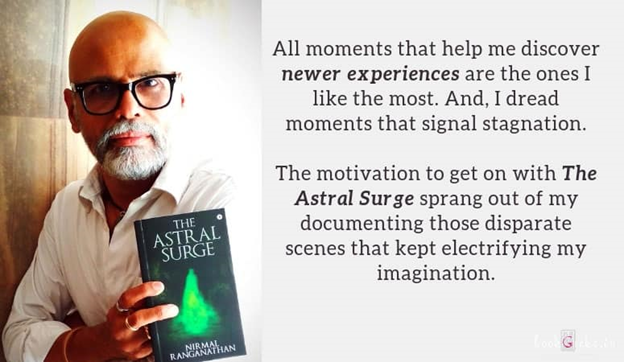Interview with Vasudev Murthy, Author of Yoga Sutras Simplified: A Soul-Searching Adventure with Patanjali
Vasudev Murthy writes in multiple genres: classical music, management, crime and humour. He draws inspiration from the violin, yoga, animal rights and insane poets. His work has been translated into Japanese, Portuguese, Hindi and Kannada.on Jan 09, 2023
.jpg)
Vasudev Murthy writes in multiple genres—classical music, management, crime and humour—and his work has been translated into Japanese, Portuguese, Hindi and Kannada. He lives in Bangalore and draws inspiration from the violin, yoga and animal rights.
Frontlist: How did the idea of simplifying complex Sanskrit sutras in layman's terms cross your mind?
Vasudev: There are plenty of books written on Vedic philosophy and more by evolved individuals. I observed that most readers have challenges in comprehending complex ideas for various reasons including the fact that they might not know much about Sanskrit or even Devanagari. This causes an average reader to pause and consider revisiting the text later, which he or she probably does not. Additionally, the current linear way of describing a text, line by line, may not always work. Often, readers want to know the basic idea, supplemented with graphics, personal anecdotes and more. Once I arrived at this formula, with help of my editor, the book flowed well.
Frontlist: What complex life questions does this book address?
Vasudev: There are quite a few. Here are a sample.
What is the purpose of this life?
Who am I, truly?
Why is my mind constantly in a state of unrest and what can I do about it?
What are the distractions I might encounter while working towards the purpose of yoga?
What are the limbs of yoga, with particular reference to social behaviour and internal discipline, and how does it help me?
What is time?
What are sources of sorrow?
Frontlist: How does the book go beyond the physical aspects of Yoga?
Vasudev: The physical aspect – the asanas – are alluded to only briefly – twice, in fact - in the 196 sutras. Patanjali’s Yogasutras defines the philosophy of yoga and says that yoga is the stilling of the mind. But that is easier said than done. He explains the state of Samadhi, the distractions along the way, the solution, the structured eight limbs of yoga, the unusual abilities you may acquire, the three gunas that result in each of us looking at the world differently and the final glorious state of dharma megha samadhi.
Frontlist: When did you first start practicing Yoga, and what changes have you experienced since rehearsing it?
Vasudev: I started my journey in Yoga decades ago when I lived in the US. It was an intermittent interest and I was only looking at it, naively, as means to better health. Later, I enrolled in a wonderful Yoga school in Bangalore and developed additional insights. My reading of the Yogasutras was rather late, but had an immediate impact in me being able to be more deliberate in my actions and becoming more aware of how mind was reacting. I practice Asanas and Pranayama every single day and I enjoy excellent physical and mental health.
Frontlist: Why do you believe people need to be well-versed in the Yoga Sutras? Please elucidate its advantages.
Vasudev: First off, the Yogasutras are a fantastic cultural and spiritual pillar of India. The advanced and superb subtle ideas expressed in the Yogasutras will elevate your thinking. Yoga is, as you know, one of the greatest contributions of India to the rest of the world. Once you get a grasp of the philosophy of yoga, your mind expands and we ponder over larger questions. The Yogasutras describe how the mind is modified constantly and what you can do to still your mind and then see the real YOU. We derive a understanding of the purpose of our life, the meaning of karma, the sources of sorrow, why we behave in certain ways, how to manage ourselves better and so on. We may understand the purpose of life. All this helps us use our time on this earth more effectively
Frontlist: Simplifying ancient complex Sanskrit texts is a challenging feat to achieve. How did you conduct your research for this book?
Vasudev: I studied the Sanskrit text and then looked at a number of interpretations. The Yogasutras have been formally explained – though in the traditional liner way, sutra after sutra - by extraordinary people like Swami Vivekananda, B K S Iyengar, Edwin Bryant, Yogacharya Bhavnani and more. What was important, I felt, was to write around the collection of ideas, rather than focus on any single one. I tried to map whatever I was reading to events in my life to give context. That worked. I used references to music and several other short stories to make the description more personal and accessible to readers. I divided the 196 sutras in eight chapters of about 25 sutras each. And there were three principles “take-aways” I listed at the end of every chapter. Very importantly, I used graphics to convey ideas. These days, people prefer graphics that convey the idea faster than words; this needs to be acknowledged.
Check out the New Author Interview



.jpg)






.jpg)
.png)
.jpg)
.jpg)
.jpg)
.jpg)
.jpg)
.jpg)










Sorry! No comment found for this post.